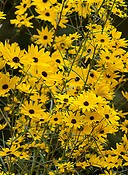 Swamp sunflower, also know as narrowleaf sunflower, is a herbaceous perennial native to eastern United States from the mid-Atlantic to Florida, west to Texas where it grows in wet areas such as swamps, salt marshes, floodplains, and disturbed sites including moist ditches. The flowerheads resemble those of the familiar annual sunflower but are smaller. They are two to three inches across and produced in abundance covering the plant in fall with their golden yellow ray flowers surrounding purplish or reddish brown disc flowers. Bees, butterflies, and other nectar-seeking insects are attracted to the flowers, birds to the seeds that follow. The rough dark green leaves are three to six inches long by one half inch wide and are borne on branched, burgundy stems. The stems have a tendency to lodge but cutting them back in in June will encourage bushiness and help avoid staking. The species is tall and useful for the back of the border but shorter cultivars are available. Swamp sunflower is an excellent choice for the wettest and mid-sections of rain gardens as well as for seashore gardens. Although endangered in some parts of its range, under ideal conditions it can spread by rhizomes and become invasive.
Swamp sunflower, also know as narrowleaf sunflower, is a herbaceous perennial native to eastern United States from the mid-Atlantic to Florida, west to Texas where it grows in wet areas such as swamps, salt marshes, floodplains, and disturbed sites including moist ditches. The flowerheads resemble those of the familiar annual sunflower but are smaller. They are two to three inches across and produced in abundance covering the plant in fall with their golden yellow ray flowers surrounding purplish or reddish brown disc flowers. Bees, butterflies, and other nectar-seeking insects are attracted to the flowers, birds to the seeds that follow. The rough dark green leaves are three to six inches long by one half inch wide and are borne on branched, burgundy stems. The stems have a tendency to lodge but cutting them back in in June will encourage bushiness and help avoid staking. The species is tall and useful for the back of the border but shorter cultivars are available. Swamp sunflower is an excellent choice for the wettest and mid-sections of rain gardens as well as for seashore gardens. Although endangered in some parts of its range, under ideal conditions it can spread by rhizomes and become invasive.
Type: Herbaceous perennial
Bloom: Golden yellow flowers 2-3″ across cover the plant in late summer to fall for about a month.
Size: 6-10′ H x 4-5′ W
Light: Full sun; becomes leggy and produces less flowers in shade
Soil: Moderately moist to wet; tolerates waterlogged soils for extended periods
Care: Cut back in fall
Hardiness: Zones 6-9
Pests and Diseases: None of significance but susceptible to downy mildew, fungal leaf spots, rust, canker, several chewing insects
Propagation: Division, seed
Companion Plants: Turtlehead (Chelone spp), cardinal flower (Lobelia cadinalis).
